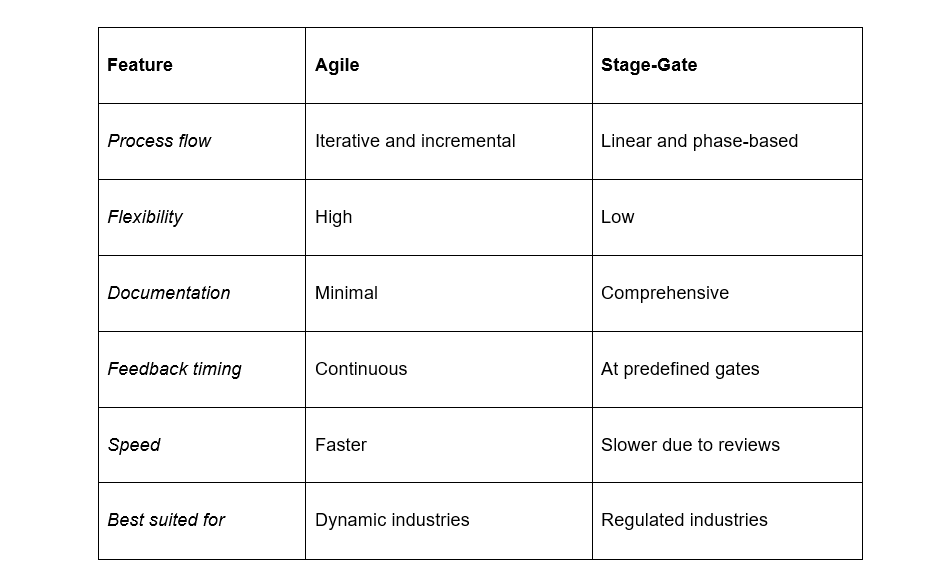Developing and launching a new product demands a strategic approach to achieve efficiency, innovation, and market success. Two widely used methodologies for new product development are agile and stage-gate. Each has distinct benefits, making it essential to understand their differences and how they might complement one another to address specific organizational needs. So, let’s start by taking a closer look at the agile methodology and its unique approach to product development.
The Basics of Agile Methodology for Product Development
Agile methodology is an iterative and adaptable process. Unlike traditional linear approaches, agile breaks the project into smaller, manageable sprints. Each sprint delivers a functional product segment that stakeholders evaluate and refine based on feedback. This cycle ensures the end product closely aligns with customer expectations.
Agile thrives in environments where requirements frequently change. It highlights the focus on collaboration across cross-functional teams and continuous input from stakeholders, minimizing the risk of creating a product that does not meet market needs.
However, agile presents certain challenges. The flexibility that fosters innovation can also result in scope creep, where project goals expand uncontrollably. Moreover, minimal documentation in agile can complicate compliance in heavily regulated industries.
Exploring the Structured Approach of Stage-Gate
The stage-gate process for new product development is a phased methodology with a sequential structure. Each phase focuses on a specific part of the project, such as ideation, planning, design, testing, and launch. At the end of each phase, gates serve as decision checkpoints to determine whether the project progresses require revision, or should stop altogether.
This structure promotes thorough risk assessment, clear accountability, and organized resource allocation. The stage-gate process for product development is versatile and does the trick across different industries, making it a handy tool for keeping projects organized and on track.
While the stage-gate development process provides structure, its rigidity can be a disadvantage in fast-paced markets. Revisiting earlier phases due to evolving needs often results in delays and higher costs. The process suits environments where requirements remain stable rather than industries characterized by rapid change.
Comparing Key Features of Agile and Stage-Gate
To evaluate stage-gate vs agile, consider how each methodology aligns with specific project goals. Let’s check out their features to determine which is better for your strategies.

Advantages of Combining Agile and Stage-Gate
Integrating agile stages within the stage-gate framework allows organizations to balance flexibility and structure. This hybrid model combines the adaptability of agile with the risk management strengths of stage-gate.
For example, the initial ideation and planning phases can follow the structured approach of stage-gate product development, ensuring thorough scoping and risk mitigation. Development and testing can adopt agile’s iterative sprints to accommodate fast feedback and adjustments. This combination works well for large-scale projects requiring both strategic alignment and adaptability.
Why Agile Excels in Fast-Changing Industries
Agile methodology offers a unique advantage in markets where requirements evolve rapidly. Its iterative process enables teams to adapt to customer needs and market changes quickly. By focusing on delivering functional increments, organizations can get their products to market faster, gaining a competitive edge.
Agile encourages strong coordination and constant feedback from everyone involved. Teams can listen to people and make improvements so they’re not stuck with ideas that no longer work. This flexible way of working ensures the final product is exactly what customers want and is in line with current trends.
Stage-Gate Offers Robust Risk Management
The stage-gate process for new product development is ideal for environments prioritizing predictability and risk management. Dividing the development into distinct stages ensures that each step is carefully planned and evaluated. Gates are critical decision points, enabling stakeholders to review progress, reassess risks, and determine the project’s next steps.
This structured approach minimizes costly mistakes and ensures the project meets regulatory and quality standards. Detailed documentation, a key aspect of stage-gate software, further supports these requirements, making the methodology highly reliable. The framework is particularly well suited for sectors where compliance with strict regulations and operational rigor is essential.
Blending Agile and Stage-Gate for Better Outcomes
A hybrid model that integrates agile and stage-gate can provide the optimal balance between flexibility and accountability. For instance, the NPD stage-gate process can guide initial concept validation and risk assessment while agile phases streamline development and testing.
This combination helps teams achieve faster delivery without sacrificing quality or compliance. Organizations adopting this hybrid approach can cater to dynamic markets while ensuring rigorous oversight in critical stages of product development.
Conclusion
Agile and stage-gate have distinct strengths, each suited to specific projects and industries. Agile’s flexibility and iterative process make it ideal for fast-changing environments, while stage-gate’s structured approach ensures reliability in regulated markets. By understanding the benefits of each methodology and exploring hybrid models, businesses can develop strategies to meet modern product development challenges.


